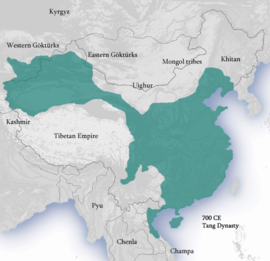An Lushan Rebellion
| An Lushan Rebellion | |||||||
|---|---|---|---|---|---|---|---|
 Tang dynasty c. 700 |
|||||||
|
|||||||
| Belligerents | |||||||
| Tang dynasty | Yan | ||||||
| Commanders and leaders | |||||||
|
Tang Xuanzong Tang Suzong Tang Daizong Feng Changqing Gao Xianzhi Geshu Han Guo Ziyi Li Guangbi Zhang Xun |
An Lushan An Qingxu Shi Siming Shi Chaoyi |
||||||
| Strength | |||||||
| c. 600,000 – 700,000 at peak | c. 200,000 – 300,000 at peak | ||||||
| Casualties and losses | |||||||
| Heavy, but uncertain | |||||||
Tang victory
The An Lushan Rebellion was a devastating rebellion against the Tang dynasty of China. The rebellion overtly began on 16 December 755, when general An Lushan declared himself emperor in Northern China, thus establishing a rival Yan Dynasty, and ended when Yan fell on 17 February 763 (although the effects lasted past this). This event is also known (especially in Chinese historiography) as the An–Shi Rebellion or An–Shi Disturbances (simplified Chinese: 安史之乱; traditional Chinese: 安史之亂; pinyin: Ān Shǐ zhī luàn), as it continued after An Lushan's death under his son An Qingxu and his deputy and successor Shi Siming, or as the Tianbao Rebellion (天宝之乱), as it began in the 14th year of that era.
The rebellion spanned the reigns of three Tang emperors before it was finally quashed, and involved a wide range of regional powers; besides the Tang dynasty loyalists, others involved were anti-Tang families, especially in An Lushan's base area in Hebei, and Arab, Uyghur and Sogdian forces or influences, among others. The rebellion and subsequent disorder resulted in a huge loss of life and large-scale destruction. It significantly weakened the Tang dynasty, and led to the loss of the Western Regions.
Beginning in 742, Eurasia entered a 13-year period of major political turmoil, with the regional empires generally suffering "a major rebellion, revolution, or dynastic change." In this year the Türk dynasty of the eastern Eurasian Steppe was overthrown and then replaced by Sogdian-influenced Uighur rulers. This was apparently the first of several revolutionary events either led by or intimately connected with the merchants and tradespeople involved with the international commerce often referred to as the Silk Road. In 747, the Abbasids began their rebellion against the Umayyad Caliphate in Merv, Khurasan, resulting in the proclamation of a new Abbasid Caliph in about 750. This rebellion also seems to have been organized by merchants and persons identifying themselves as merchants.
...
Wikipedia
